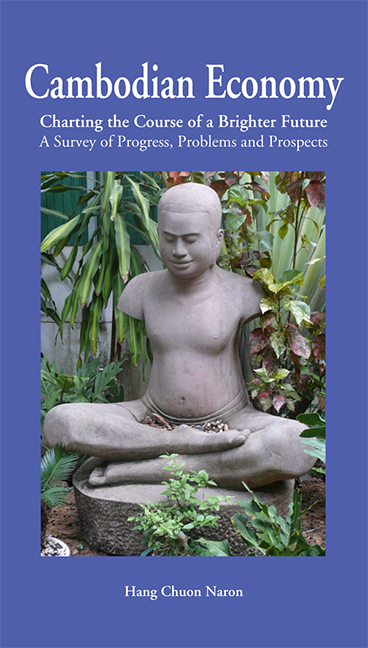 Cambodian Economy
Cambodian Economy Published online by Cambridge University Press: 21 October 2015
“Development is by definition a process of change. The increase in productivity and intensification of agriculture, the abandoning of farming activity in favor of employment in industry and services, and the consequent rural exodus, are all decisive factors in this process.”
Nicholas SternAfter more than three decades of civil war, Cambodia has experienced relative peace since 1998 and has been rebuilding its infrastructure, economy, and social fabric, and thereby enabling the country to redirect its resources and strengths toward sustained, equitable development. The country's achievements during the 20 years of reconstruction from January 1979 onward show what the Cambodian people are capable of doing when they put their talents and ingenuity to work for a peaceful cause. Cambodia is now back on track to achieve its destined place in the vanguard of the community of nations.
Three significant phases in the recent economic history of Cambodia can be discerned: A period of rebuilding from 1979-1990, a transition and reconstruction phase from 1991-1998, and a development phase beginning in 1999. Cambodia's economy grew steadily in all the three phases.
Cambodia had to virtually start from the scratch to rebuild the country after the defeat of the Khmer Rouge regime. At the very outset, the country had to face the harmful consequences of the economic embargo imposed in 1979. The annual rate of economic growth did not exceed 3.4% during 1988-1991, even though average annual growth in the manufacturing sector reached 6.3%.
Growth has been particularly strong since the early 1990s, with the implementation of macroeconomic reforms and normalization of economic and trade relations with the countries of the region. An annual average rate of 6.3% was achieved during 1994-1998, despite the upheaval caused by the Asian financial crisis of 1997-1998.
Since 1999, Cambodia has been working towards accelerating development. Growth was 11.9% in 1999, although slowing to 6.6% in 2002, with an annual average rate of 8.8% for the five-year period of 1999-2003. This growth is attributed to two flourishing sectors: garments and tourism.
To save this book to your Kindle, first ensure [email protected] is added to your Approved Personal Document E-mail List under your Personal Document Settings on the Manage Your Content and Devices page of your Amazon account. Then enter the ‘name’ part of your Kindle email address below. Find out more about saving to your Kindle.
Note you can select to save to either the @free.kindle.com or @kindle.com variations. ‘@free.kindle.com’ emails are free but can only be saved to your device when it is connected to wi-fi. ‘@kindle.com’ emails can be delivered even when you are not connected to wi-fi, but note that service fees apply.
Find out more about the Kindle Personal Document Service.
To save content items to your account, please confirm that you agree to abide by our usage policies. If this is the first time you use this feature, you will be asked to authorise Cambridge Core to connect with your account. Find out more about saving content to Dropbox.
To save content items to your account, please confirm that you agree to abide by our usage policies. If this is the first time you use this feature, you will be asked to authorise Cambridge Core to connect with your account. Find out more about saving content to Google Drive.